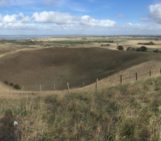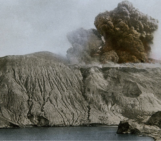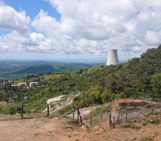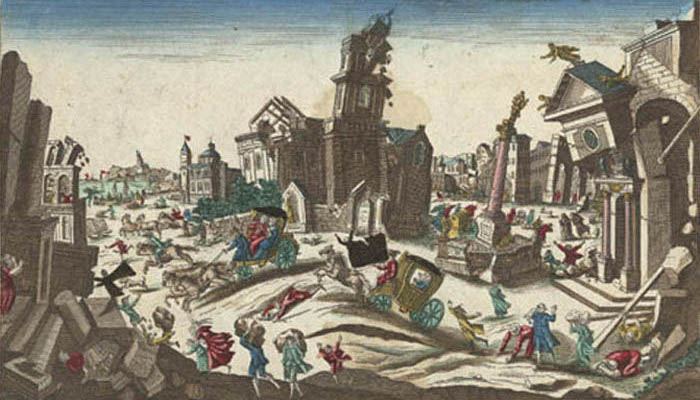
This edition of “Beyond Tectonics” is brought to you by Katrin Kleemann. Katrin is a doctoral candidate at the Rachel Carson Center/LMU Munich in Germany, she studies environmental history and geology. Her doctoral project investigates the Icelandic Laki fissure eruption of 1783 and its impacts on the northern hemisphere.
“A Violent Revolution of Planet Earth” – The Calabrian Seismic Sequence of 1783
The 1783 “Year of Awe”
In 1783, a sequence of several strong earthquakes devastated Calabria, later that year the Icelandic Laki fissure eruption blanketed parts of the northern hemisphere with a strange, dry sulfuric fog. Contemporaries coined 1783 to be an annus mirabilis, a year of awe, that saw many unusual phenomena: A temporary “burning island” appeared off the coast of Iceland; earthquakes rocked parts of Western Europe and even the Middle East; there were erroneous reports of at least three volcanic eruptions in Germany (this news was later retracted); and in September, news of a volcanic eruption at or near Mount Hekla, Iceland’s most infamous volcano, reached the European mainland. All of these events inspired the notion that somewhere “a violent revolution of planet Earth” was underway (Münchner Zeitung 1783). The most popular theory at the time was that the earthquakes in Calabria had caused the sulfuric-smelling dry fog of 1783.
The volcanic eruptions in Iceland, and earthquakes in Italy are both caused by their respective geology. Iceland sits on the Mid-Atlantic Ridge, a divergent boundary between the Eurasian and the North American plate, and on top of the Iceland mantle plume, making it very volcanically active. The Italian peninsula is dominated by a subduction zone – between the Eurasian and African plates – which reaches from Sicily to Northern Italy and causes many earthquakes.
How do we know the strength of these historic earthquakes, when they occurred before seismometers had been invented? Geologists estimate the magnitude of historical earthquakes from written reports that describe the damage caused. The Mercalli-Cancani-Sieberg scale (MCS), named after Giuseppe Mercalli, Adolfo Cancani, and August Heinrich Sieberg, is one scale to infer the magnitude of an earthquake from historical descriptions: the MCS scale reaches from level I (earthquake “not felt”) to level XII (“extreme”, causing total damage, waves seen on ground surfaces, objects being thrown upward into the air).
“The most terrible and destructive of any earthquake”
With the presence of the Calabrian Arc – characterized by normal faulting and uplift – and the volcanoes of Etna and Stromboli nearby, Southern Italy and Sicily experience regular earthquakes and volcanic eruptions. However, the earthquakes of early 1783 did not follow the normal pattern of one strong quake and weaker fore- and/or aftershocks. Instead, there was a seismic sequence of five strong earthquakes. A seismic sequence is an unusual event, in which one earthquake increases the stress on other parts of the fault system, which triggers subsequent earthquakes. This process is called Coulomb stress transfer.
“The Earthquakes in Italy were, perhaps, the most terrible and destructive of any that have happened since the Creation of the World. Four hundred towns, and about four or five times as many villages, were destroyed in this dreadful calamity. The number of lives lost, are estimated at between forty and fifty thousand.” An Account of the Earthquakes in Calabria, Sicily, and other parts of Italy, in 1783. Communicated to the Royal Society [of London], by Sir William Hamilton, the British Ambassador to the Kingdom of the Two Sicilies in Naples, May 23, 1873.”
Today we know, these were not, in fact, the most destructive earthquakes of all time, although in 1783 these unusual earthquakes, and the hundreds of aftershocks that occurred throughout the year certainly seemed that way.

A contemporary print of the first of the 1783 Calabrian earthquakes. The earthquake caused severe damage and destruction in Reggio Calabria in the foreground, with the Strait of Messina in the background. Image source: Wikipedia.
The earthquakes in Calabria and their consequences
The print above illustrates the first of the Calabria earthquakes, which occurred on February 5, 1783, at noon, near Oppido Mamertina in Calabria, which was a XI on the MCS scale (Richter magnitude of 7.0). It gives us an idea of the extreme destructive force of this earthquake. The residents of Messina and Calabria were knocked off their feet by the shaking as they tried to flee, avoiding cracks in the ground, and falling trees and rubble (Jacques et al., 2001). Contemporary reports show the initial earthquake destroyed almost all of the nearby buildings, and the initial and subsequent earthquakes caused total casualties in the tens of thousands.

Map of the intensity of the first large earthquake on 5 February 1783, which reached a XI of the Mercalli scale, here symbolized in dark purple. A star denotes the point of the epicenter of the earthquake (credit CFTI).
The second strong earthquake, which also reached VIII-IX on the MCS scale (“severe” to “violent”), struck only half a day later, at 0:20 am. The first earthquake had scared many people in the region, and they did not want to spend the night in their houses. In Scilla (in NW Calabria), many people decided to camp on the beach overnight. This proved to be a fatal error: The second earthquake triggered a rockslide, which created a tsunami that killed 1500 people on the beach (Bozzano et al., 2011; Mazzanti et al., 2011).
The extraordinary weather phenomena of 1783
During the summer of 1783, another highly unusual phenomenon was present in Europe: A sulfuric-smelling dry fog hung in the air for weeks on end. Many naturalists and amateur weather observers around Europe noticed this phenomenon and speculated as to its cause. At the time, it was believed that sulfuric fogs were a precursor to strong earthquakes, a dry fog was observed in the days before the 1755 Lisbon earthquake – most likely produced by an eruption of the Icelandic volcano Katla. A similar fog was also reported in Calabria on February 4, 1783 (Kiessling, 1888; von Hoff, 1840).
We now know that the Icelandic Laki Fissure eruption, of 1783, released large amounts of gases and ash, which were carried towards continental Europe via the jet stream. However, news of this took almost three months to reach Europe, by which time the dry fog had vanished again, making it difficult to explain the phenomenon at the time.
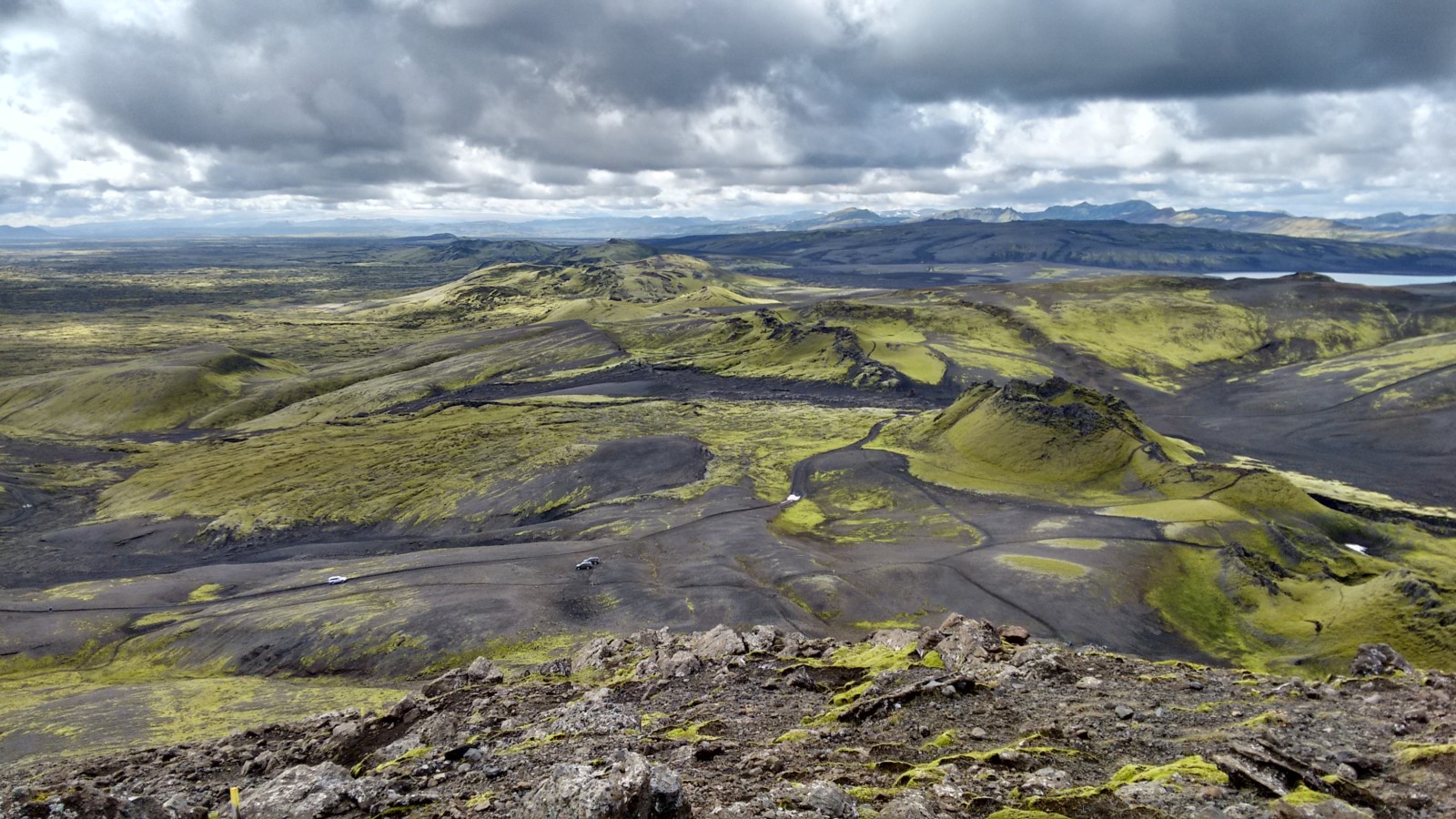
The Southwestern part of the Laki Fissure in Iceland today (credit Katrin Kleemann).
How to explain earthquakes without the theory of Plate Tectonics
The sheer number of unusual subsurface phenomena observed during this time seemed overwhelming. Many theories were developed to explain the “year of awe,” one suggested the Calabria earthquakes had created a crack in the Earth, which was releasing the sulfuric fog observed over Europe. For a very long time, it remained only one theory among many.
In the late eighteenth century, it was believed that all volcanoes, most often coined “fire (spitting) mountains,” were connected via fire channels inside the Earth. Earthquakes and volcanic eruptions were believed to be caused by chemical reactions—between gas or metals and water for instance—in subterranean passages and caverns (Reinhardt et al., 1983; Oldroyd et al., 2007). Today, we have the theory of plate tectonics and mantle plumes, however, even today, the geology of the Calabrian Arc seems very complex and is far from fully understood.
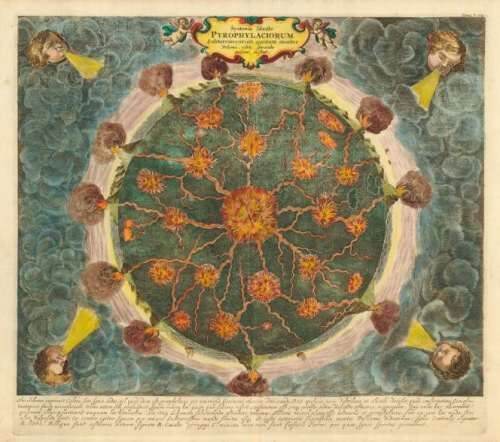
“Subterraneus Pyrophylaciorum“: Fire canals connecting all volcanoes on the planet, depicted in Athanasius Kircher’s Mundus Subterraneus, 1668 (credit Wikimedia commons).
Written by Katrin Kleemann
Edited by Hannah Davies
References/extra reading
- Bozzano, F., Lenti, L., Martino, S., Montagna, A. and Paciello, A., 2011, Earthquake triggering of landslides in highly jointed rock masses: Reconstruction of the 1783 Scilla rock avalanche (Italy). Geomorphology, 129 (3-4), 294 – 308.
- Graziani, L., Maramai, A. and Tinti, S., 2006, A revision of the 1783-1784 Calabrian (southern Italy) tsunamis. Natural Hazards and Earth System Sciences, 6 (6), 1053 – 1060.
- Hamilton, W., 1783, An account of the late earthquakes in Calabria, Sicily, &c. Colchester: J. Fenno.
- Jacques, E., C. Monaco, P. Tapponnier, et al., 2001, Faulting and earthquake triggering during the 1783 Calabria seismic sequence. Geophysical Journal International, 147, 499 – 516.
- Kiessling, K. J., 1888, Untersuchung über Dämmerungserscheinungen zur Erklärung der nach dem Krakatau-Ausbruch beobachteten atmosphärisch-optischen Störungen. Hamburg: L. Voss, 26.
- Kleemann, K, 2019. Living in the Time of a Subsurface Revolution: The 1783 Calabrian Earthquake Sequence. Environment & Society Portal, Arcadia (Summer 2019), no. 30. Rachel Carson Center for Environment and Society. http://www.environmentandsociety.org/node/8767.
- Kleemann, K., 2019, Telling stories of a changed climate: The Laki Fissure eruption and the interdisciplinarity of climate history. Edited by K. Kleemann and J. Oomen, RCC Perspectives: Transformations in Environment and Society no. 4, 33-42, doi.org/10.5282/rcc/8823. http://www.environmentandsociety.org/sites/default/files/03_kleemann.pdf
- Kozák, J., and Cermák, V., 2010, The illustrated history of natural disasters. Dordrecht: Springer Netherlands.
- Mazzanti, P. and Bozzano, F., 2011, Revisiting the February 6th 1783 Scilla (Calabria, Italy) landslide and tsunami by numerical simulation. Marine Geophysical Research, 32 (1-2), 273 – 286.
- Oldroyd, D., Amador, F., Kozáko, J, Carneiro, A, and Pinto, M., 2007, The study of earthquakes in the hundred years following the Lisbon earthquake of 1755. Earth Sciences History 26 (2), 321 – 370.
- Placanica, A., 1985, Il filosofo e la catastrophe: Un terremoto del Settecento. Turin: Einaudi.
- Reinhardt, O., and Oldroyd, D. R., 1983, Kant’s theory of earthquakes and volcanic action. Annals of Science, 40 (3), 247 – 272.
- Von Hoff, K. E. A., 1840, Chronik der Erdbeben und Vulcan-Ausbrüche: mit vorausgehender Abhandlung über die Natur dieser Erscheinungen 1 Vom Jahre 3460 vor, bis 1759 unserer Zeitrechnung. Volume 1. Gotha: Perthres, 108.

